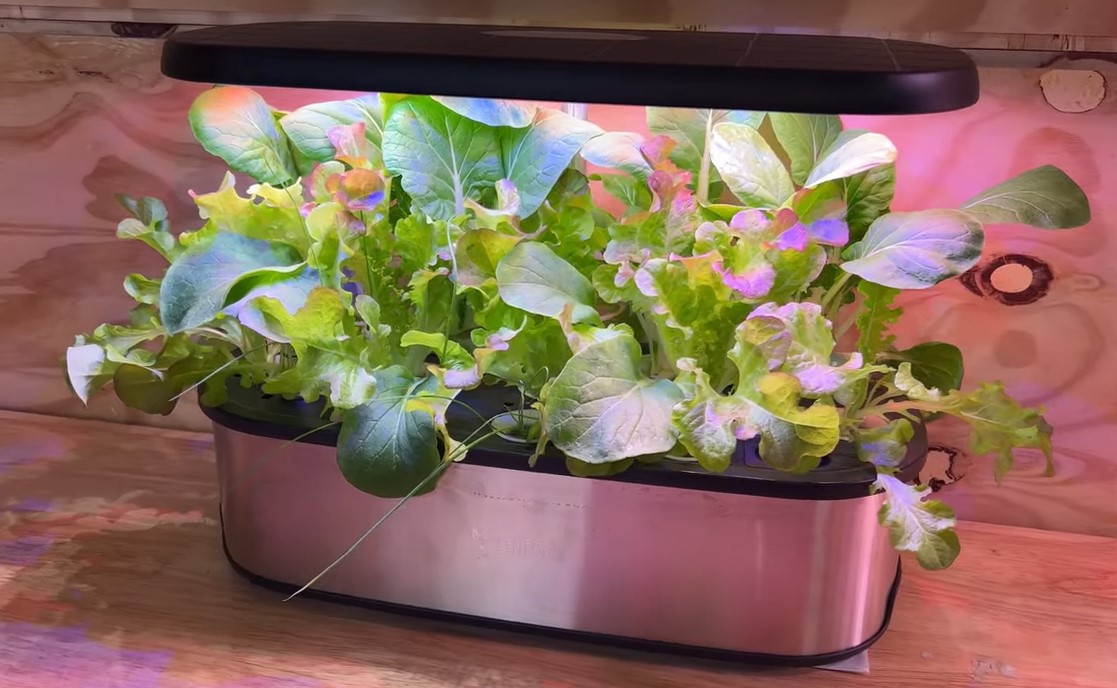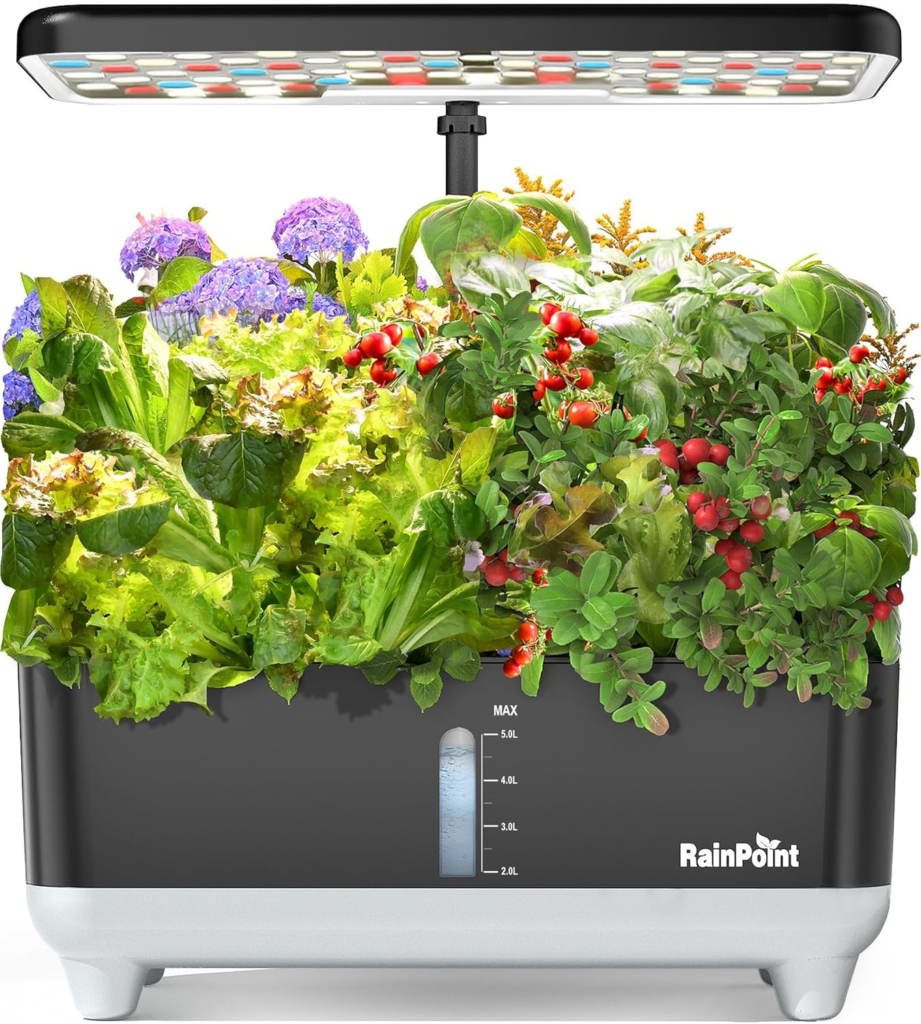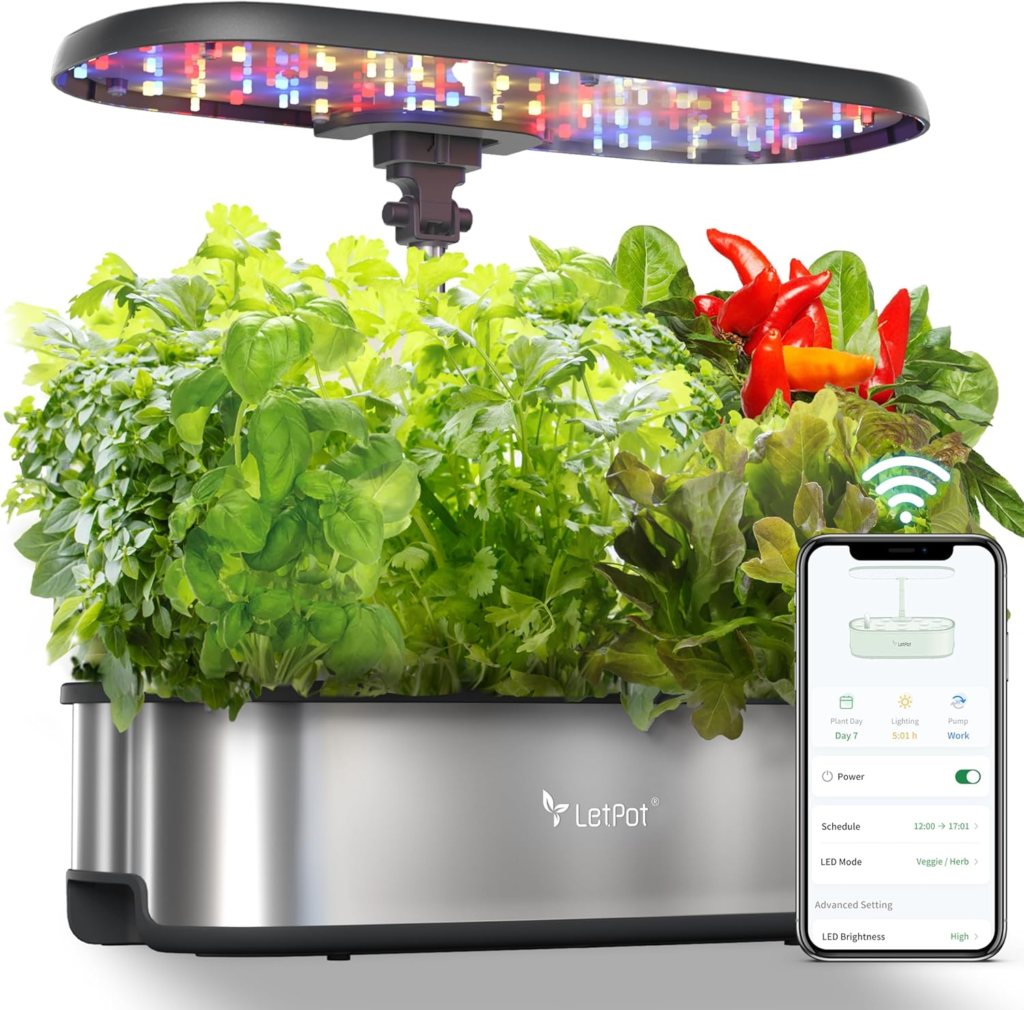Hydroponics has transformed modern gardening, especially for urban dwellers and those with limited outdoor space. As a newcomer to soilless cultivation, you might feel overwhelmed by technical terms and complex setups. Don’t worry! This comprehensive guide will cover the essentials of hydroponics and introduce you to some of the best hydroponic systems for beginners. Whether you’re looking to grow herbs, vegetables, or small plants indoors, these beginner-friendly hydroponic systems are the perfect starting point for hydroponic gardening.
As an Amazon affiliate, I earn from qualifying purchases at no extra cost to you.
Understanding Hydroponics: The Basics
Hydroponics is a method of growing plants without soil, using nutrient-rich water instead. This technique allows for faster growth, higher yields, and year-round cultivation, all while using less water than traditional gardening methods. The key components of a hydroponic system include:
- A growing container
- A nutrient solution
- A method for delivering the solution to the plants
- A growing medium (optional in some systems)
- Lighting (if growing indoors)
Now that we’ve covered the fundamentals, let’s explore some of the best hydroponic systems for beginners.
Top Hydroponic Systems for Newcomers
1. Ahopegarden Hydroponics Growing System kit
The Ahopegarden system The Ahopegarden system is an excellent choice for those starting their hydroponic adventure. This system boasts impressive features that make it user-friendly and effective.
Key Features:
- Full-spectrum LED lights for optimal plant growth
- Smart timer for automated light cycles
- One-touch LCD control for easy monitoring
- Quiet water pump for effective root oxygenation
- 5L water tank capacity
- Dual growing modes for various plant types
The Ahopegarden system can grow plants up to 300 percent faster than traditional soil methods. Its vertical design is a major advantage for people with limited space, allowing you to maximize your growing area without sacrificing floor space.
The full-spectrum LED lights mimic natural sunlight, providing your plants with the ideal light conditions for photosynthesis. The smart timer confirms your plants receive the right amount of light each day, simulating natural day and night cycles.
The one-touch LCD control makes it easy to watch and adjust your system’s settings. You can easily check water levels, nutrient concentrations, and light cycles without any complicated procedures.
The quiet water pump is a crucial component, continuously circulating the nutrient solution and oxygenating the roots. This process promotes healthy root growth and nutrient uptake, resulting in stronger, more productive plants.
With a 5L water tank capacity, you won’t need to refill the system as frequently, making it low-maintenance and ideal for busy individuals. The dual growing modes allow you to customize the system for different types of plants, from leafy greens to compact fruiting plants.

View the Ahopegarden Hydroponics here.
2. IDOO Hydroponics Growing System Kit
For tech-savvy beginners, the iDOO system offers an impressive array of smart features that make hydroponic gardening a breeze.
Standout Features:
- WiFi connectivity with smartphone app control
- Digital plant growth diary
- Large 6.5L water tank for extended periods between refills
- 22W full-spectrum LED grow light
- Built-in fan for heat distribution and pollination
- Smart water shortage alerts
The ability to control your garden remotely is a game-changer, especially for busy people or frequent travelers. The app allows you to adjust lighting, fan, and pump settings from anywhere, ensuring your plants always receive optimal care.
The digital plant growth diary is a unique feature that helps you track your plants’ progress over time. You can record important milestones, note any issues, and learn from your experiences to improve future grows.
The large 6.5L water tank means you can go longer between refills, reducing maintenance time. The 22W full-spectrum LED grow light provides your plants with the perfect light spectrum for robust growth and development.
The built-in fan serves two important purposes: it helps distribute heat evenly throughout the growing area and aids in pollination for flowering plants. This feature is particularly useful for plants like tomatoes or peppers that require pollination to produce fruit.
Smart water shortage alerts confirm you never accidentally let your plants dry out. The system will notify you when it’s time to refill the water tank, preventing any potential damage to your plants because of dehydration.
Check out the iDOO Hydroponics Growing System Kit here
3. URBZUE Hydroponics Growing System Kit
The URBZUE Hydroponics Growing System is perfect for beginners, featuring easy-to-use controls, a 24-hour auto cycle timer, and a low-maintenance setup that ensures hassle-free plant care and growth.
Key Elements
- Delivers nutrient-rich mist directly to plant roots, promoting faster growth and better oxygenation.
- Uses 50% less water than hydroponic systems, providing optimal humidity for roots while conserving resources.
- Three modes (Normal, Quick Grow, and Vacation) allow you to adjust settings based on plant needs.
- Ensures consistent care and light control, perfect for various plant types and environments.
- The nearly silent pump and adjustable water temperature enhance germination and plant growth year-round, even in colder months.
- Accommodates plants up to 20 inches tall, ideal for a variety of crops including herbs, vegetables, and flowers.
- Provides ample space to grow multiple plants simultaneously, making it perfect for indoor gardening.
The URBZUE Aeroponics Growing System delivers nutrient-rich mist in seconds, enhancing root oxygenation and accelerating plant growth while using 50% less water than hydroponics. With three growing modes, a 24-hour auto cycle timer, and adjustable light dimming, users can customize settings for optimal plant health. Its nearly silent, winter-optimized pump, 15 planting pods, and adjustable 20-inch height ensure efficient, year-round indoor gardening.
Learn more about the URBZUE Hydroponics Growing System Kit
4. RAINPOINT Hydroponics Growing System Kit
The RAINPOINT system offers a great balance of simplicity and functionality, making it ideal for beginners who want a straightforward setup without sacrificing features.
Key Attributes:
- 13 planting pods for a variety of herbs and vegetables
- 5L water tank capacity
- LED grow light included
- Smart water pump with automatic timer
- Easy-to-use design for hassle-free maintenance
This system’s simplicity doesn’t come at the cost of versatility. With 13 pods, you can grow a diverse range of plants, from leafy greens to compact fruiting plants like cherry tomatoes or small peppers.
The 5L water tank capacity strikes a good balance between size and efficiency. It’s large enough to require infrequent refills but not so large that it becomes cumbersome or takes up too much space.
The included LED grow light provides your plants with the necessary light spectrum for healthy growth. This feature is particularly useful if you’re growing in an area with limited natural light.
The smart water pump with an automatic timer confirms your plants receive regular nutrient solution without the need for constant manual operation. This feature is especially useful for beginners who might forget to water their plants regularly.
The easy-to-use design makes maintenance a breeze. Even if you’ve never gardened before, you’ll find this system intuitive and straightforward to operate.
Discover the RAINPOINT Hydroponics Growing System Kit
5. LetPot LPH-SE Hydroponics Growing System
For those who love the idea of a smart garden, the LetPot LPH-SE system offers modern features in a beginner-friendly package.
Impressive Features:
- WiFi connectivity with app control
- 12 planting pods
- 24W LED grow light
- User-friendly interface
- Sleek, modern design
The WiFi connectivity and app control make this system particularly appealing to tech-enthusiasts who want to watch and adjust their garden settings remotely. It’s a great way to combine your new hobby with your smart home setup.
With 12 planting pods, you have plenty of space to grow a variety of herbs, leafy greens, or small fruiting plants. This allows you to experiment with different plant combinations and find what works best for your needs.
The 24W LED grow light provides powerful illumination for your plants, ensuring they receive enough light even in areas with limited natural sunlight. This feature is particularly useful for indoor growing or during winter months when daylight hours are shorter.
The user-friendly interface makes it easy to watch and adjust your system’s settings, even if you’re new to hydroponics. You can easily check water levels, nutrient concentrations, and light cycles without any complicated procedures.
The sleek, modern design of the LetPot LPH-SE means it won’t look out of place in your kitchen, living room, or office. It’s not just a functional growing system – it’s also an attractive piece of home decor.
View the LetPot LPH-SE Hydroponics Growing System
Tips for Success with Your New Hydroponic System
Now that we’ve explored some great options for beginners, let’s talk about how to make the most of your new hydroponic system:
Start with Easy-to-Grow Plants
Herbs like basil, mint, and cilantro, or leafy greens like lettuce and spinach are great choices for beginners. These plants are generally forgiving and grow quickly, providing you with early success and motivation to continue.
Basil, for example, thrives in hydroponic systems and can be ready for harvest in as little as 3-4 weeks. Lettuce is another excellent choice, often ready for harvest in 4-5 weeks.
These quick-growing plants allow you to see results quickly and gain confidence in your hydroponic skills.
Monitor Your Nutrient Solution
Regularly check the pH and EC (electrical conductivity) levels of your nutrient solution to confirm your plants are getting the right balance of nutrients. The ideal pH range for most hydroponic plants is between 5.5 and 6.5, while the optimal EC range varies depending on the plant type and growth stage.
Invest in a good quality pH meter and EC meter to accurately measure these levels. Adjust the pH using pH up or down solutions as needed, and maintain the fix EC by adding nutrients or diluting the solution with water.
Keep It Clean
Regular cleaning of your system will prevent algae growth and keep your plants healthy. Most systems come with cleaning instructions, so be sure to follow them.
Generally, you should clean your system between grow cycles or every 4-6 weeks, whichever comes first.
To clean your system:
-
Remove all plants and growing media
-
Drain the nutrient solution
-
Scrub all surfaces with a mild detergent or hydrogen peroxide solution
-
Rinse thoroughly with clean water
-
Reassemble the system and refill with fresh nutrient solution
Regular cleaning prevents the buildup of harmful bacteria and algae that can negatively impact plant health and growth.
Pay Attention to Lighting
If you’re growing indoors, make sure your plants are getting enough light. Most of the systems we’ve discussed come with built-in lights, but you may need to adjust the height or duration as your plants grow.
Different plants have different light requirements. Leafy greens and herbs generally need about 12-16 hours of light per day, while fruiting plants like tomatoes or peppers may require up to 18 hours.
As your plants grow taller, you may need to adjust the height of your lights to maintain the optimal distance. Generally, LED grow lights should be kept 6-12 inches above the plant canopy.
Learn from Your Experiences
Keep a journal of your hydroponic journey. Note which plants thrive, any challenges you face, and how you overcome them.
This will be invaluable as you expand your hydroponic garden.
Record details such as:
-
Plant types and varieties
-
Nutrient solution composition and changes
-
pH and EC levels
-
Light cycles
-
Growth rates and harvest times
-
Any issues encountered (e.g., nutrient deficiencies, pests) and how you resolved them
This information will help you refine your techniques and make informed decisions for future grows.
Embracing the Hydroponic Lifestyle
As you begin your hydroponic adventure, remember that it’s a learning process. Don’t be discouraged if your first tries aren’t perfect – every gardener, whether using soil or water, faces challenges.
The key is to stay curious, be patient, and enjoy the process of growing your own food.
Hydroponics offers many benefits over traditional soil gardening:
-
Water Efficiency: Hydroponic systems use up to 90% less water than traditional soil gardens.
-
Space Saving: You can grow more plants in a smaller area, making it ideal for urban environments or small spaces.
-
Faster Growth: Plants in hydroponic systems often grow 30-50% faster than in soil.
-
Year-Round Growing: With indoor systems, you can grow fresh produce regardless of the season or climate.
-
Reduced Pest and Disease Issues: Without soil, many common garden pests and diseases are eliminated.
-
Precise Nutrient Control: You have finish control over the nutrients your plants receive, allowing for optimal growth and yield.
As you become more comfortable with your hydroponic system, you may want to experiment with different plant varieties or even try more advanced techniques like nutrient film technique (NFT) or deep water culture (DWC).
Whether you’re growing fresh herbs for your kitchen or cultivating a variety of vegetables, hydroponics allows you to take control of your food production in a sustainable and effective way.
With these beginner-friendly systems and tips, you’re well-equipped to start your hydroponic journey. Before you know it, you’ll be harvesting fresh, homegrown produce right from your living room or kitchen.
People Also Asked
What are the easiest plants to grow hydroponically?
Leafy greens like lettuce and spinach, along with herbs such as basil, mint, and cilantro, are among the easiest plants to grow hydroponically. These plants have relatively simple nutrient requirements and grow quickly, making them ideal for beginners.
How often should I change the water in my hydroponic system?
The frequency of water changes depends on your system size and the types of plants you’re growing. Generally, you should change the nutrient solution every 2-3 weeks or when the water level drops by about 50%.
Always watch your plants and adjust as needed.
Can I use tap water for hydroponics?
While tap water can be used for hydroponics, it’s important to let it sit for 24 hours to allow chlorine to evaporate. If your tap water is hard, you may need to use a reverse osmosis system or add pH adjusters to achieve the optimal pH range for your plants.
What’s the difference between hydroponics and aeroponics?
Hydroponics involves growing plants in nutrient-rich water, while aeroponics suspends plant roots in air and mists them with nutrient solution. Aeroponics typically provides more oxygen to the roots, which can lead to faster growth, but it’s generally more complex and better suited for experienced growers.
How much light do hydroponic plants need?
Most hydroponic plants need 12-16 hours of light per day. However, this can vary depending on the plant type.
Leafy greens and herbs generally require less light than fruiting plants like tomatoes or peppers, which may need up to 18 hours of light daily.
Is hydroponics more expensive than traditional gardening?
While the initial setup cost for a hydroponic system can be higher than traditional gardening, it can be more cost-effective in the long run. Hydroponic systems use less water, require fewer pesticides, and can produce higher yields in a smaller space.
Can I grow organic produce hydroponically?
Yes, it’s possible to grow organic produce hydroponically. You’ll need to use organic nutrient solutions and follow organic growing practices.
However, current USDA organic certification doesn’t include most hydroponic growing methods.
How do I prevent algae growth in my hydroponic system?
To prevent algae growth, keep your system clean, use opaque containers to block light from the nutrient solution, and confirm proper air circulation. Regular maintenance and cleaning of your system will go a long way in preventing algae issues.
What’s the best temperature for hydroponic growing?
Most hydroponic plants thrive in temperatures between 65°F and 75°F (18°C to 24°C). However, the optimal temperature can vary depending on the specific plants you’re growing.
It’s important to maintain a consistent temperature to avoid stressing your plants.
Can I use hydroponic systems outdoors?
Yes, hydroponic systems can be used outdoors. However, you’ll need to consider factors like temperature fluctuations, rainfall, and pests.
Some growers use greenhouse structures to protect their outdoor hydroponic systems while still benefiting from natural sunlight.
Key Takeaways
-
Hydroponics offers faster growth, higher yields, and year-round cultivation compared to traditional gardening methods.
-
Beginner-friendly hydroponic systems often come with built-in LED lights, automated timers, and easy-to-use controls.
-
Smart hydroponic systems with WiFi connectivity allow for remote monitoring and control of your garden.
-
Start with easy-to-grow plants like herbs and leafy greens to build confidence in your hydroponic skills.
-
Regular maintenance, including monitoring nutrient levels and cleaning your system, is crucial for successful hydroponic gardening.
Tips for Successful Hydroponic Gardening
- Start Small: Begin with easy-to-grow herbs like basil, mint, or lettuce to build your confidence.
- Monitor Nutrient Levels: Use the recommended nutrient solutions and regularly check the water’s pH levels to ensure optimal plant health.
- Maintain Proper Lighting: Ensure your plants receive adequate light, either through natural sunlight or the system’s built-in grow lights.
- Keep the System Clean: Regularly clean your hydroponic system to prevent algae growth and maintain a healthy environment for your plants.
Final Thoughts
Starting a hydroponic garden is a rewarding endeavor that brings the joy of gardening indoors. By choosing a beginner-friendly system like the ones mentioned above, you can enjoy fresh, home-grown herbs and vegetables year-round. Remember to follow the manufacturer’s instructions and take advantage of the resources available to learn more about hydroponic gardening.




